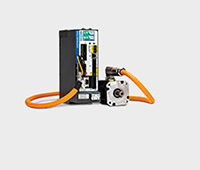The Internet of Things is real, but it is not about accessing everything from everywhere. It’s about accessing what is necessary in a way that provides the most value, and the right communication infrastructure will ensure that this is exactly what happens.
Mike Granby • President • Red Lion Controls
The Internet of Things, the Connected Factory and Industry 4.0 are being hyped as new paradigms that will revolutionize interactions between humans and their devices. From home appliances to industrial automation, these concepts hold great promise, but what are the practical steps needed to get there? For the industrial market, the story is one of evolution rather than revolution.
Advances in connectivity have come in stages, with communication first being established between devices in a panel, then between panels in a machine, then between machines in a cell, and now between cells in a factory and even between different operational factories or supply chain partners. The strength of TCP/IP as a transport protocol has helped drive the latter stages of this communication journey, and now the availability of cheap, reliable bandwidth between sites—either through wired or wireless connections—allows data to flow outside the boundaries of traditional business locations.
The discrete steps in this journey are reflected in the architecture that is and should be adopted. A few years ago, the vision was for every device in the world to have its own unique address. IP version 4 (IPv4)—the predominate protocol on which the Internet was built—has a theoretical limit of roughly four billion addresses, and it was predicted that the world would run out of these addresses causing havoc with device deployment. IP version 6 (IPv6) was created to divert this catastrophe by expanding address space. However, outside certain important, but limited realms, IPv6 has not caught on.
The transition to IPv6 has stalled, as there are more secure and easier-to-deploy solutions available that leverage existing equipment and will prolong the depletion of IPv4 addresses for a significant period of time. One method, Network Address Translation (NAT), allows all of the devices on a private network to access the Internet through a single public IP address. All outbound connections appear to come from this single address, while inbound connections to that IP are translated and mapped to specific devices on the internal network. This removes the need for large numbers of public IP addresses and increases security by obscuring the network behind a single address.
NAT is considered the right way to design a network, hiding internal network devices and only exposing pertinent functions and features from equipment to the rest of the network. Best practices for networks use a combination of equipment isolation as well as flexible architecture for ever changing application requirements. This applies just as much with the addition of the next layer of connectivity as it has always applied within the factory itself.

So what does this mean in reality? Most importantly, it means security at every level of the system. Within a production cell in a factory, for instance, a gateway can hide the network equipment contained within and pass only operational data upstream. At higher layers in the organization, similar gateways will perform analogous functions, allowing access where it is required and segregating traffic into manageable domains.
We also see the cloud playing a role in manufacturing. The need for static IP addresses may become unnecessary, with site-level gateways establishing virtual private network (VPN) tunnels to cloud-based servers, such that anyone wishing to access that site must connect to those same servers. This is already happening with cellular routers. Industrial networking devices like these use this technique to work around limitations in cellular data plans that restrict inbound connections. Similar to NAT, what started out as a matter of convenience is now being recognized as the best practice and a technique that is equally applicable to wired networks.
While many global manufacturers are eager to realize the benefits of increased connectivity, such as reduced operational costs and better visibility and control, those who are not constructing green-field facilities understand that it is unrealistic and cost-prohibitive to “rip-and-replace” legacy equipment. Plant managers are better off leveraging existing devices and equipment by integrating industrially fluent communication devices and protocol conversion software to tie all systems together. This approach not only saves time and money, but also adds real-time reporting and control functions to existing applications.
Red Lion
redlion.net
Filed Under: Appliance engineering + home automation, Wireless devices, MOTION CONTROL





Tell Us What You Think!